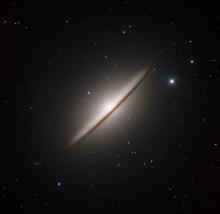Listen to today's episode of StarDate on the web the same day it airs in high-quality streaming audio without any extra ads or announcements. Choose a $8 one-month pass, or listen every day for a year for just $30.
You are here
Hercules A
A supermassive black hole can be a powerhouse. Its gravity pulls in huge amounts of gas and dust, forming a superhot disk around the black hole. And magnetic fields within the disk can fire out “jets” of gas at almost the speed of light.
Some of the more impressive jets are in Hercules A — a giant galaxy that’s more than two billion light-years away. It’s in the constellation Hercules, which is high in the sky at nightfall.
Jets fire out of the middle of the galaxy, in opposite directions. From end to end, they span more than a million and a half light-years.
Hercules A is impressive. It’s a thousand times the mass of our home galaxy, the Milky Way. And the black hole in its heart is a thousand times the mass of the Milky Way’s black hole.
A lot of gas has funneled into the black hole — perhaps as the result of a merger with another galaxy. In fact, the black hole itself could have merged with the other galaxy’s black hole about 20 million years ago. That changed the angle of the black hole, which in turn changed the angle of the jets.
As the jets ram into the material around Hercules A, they produce huge amounts of radio waves and X-rays, making the jets billions of times brighter than the Sun. The jets also squeeze the surrounding material, which triggers the birth of new stars.
But there’s evidence that the activity around the black hole is slowing down — choking off the “powerhouse” at the center of Hercules A.
Script by Damond Benningfield





